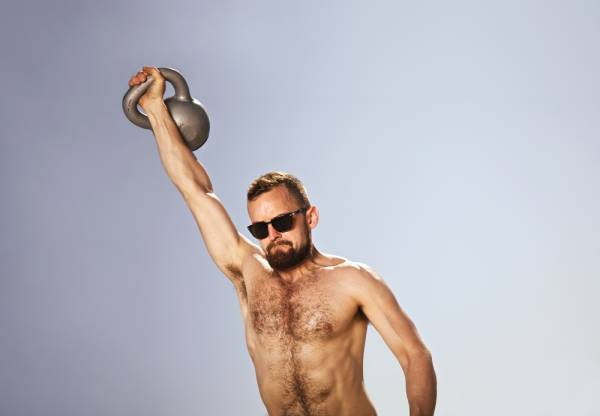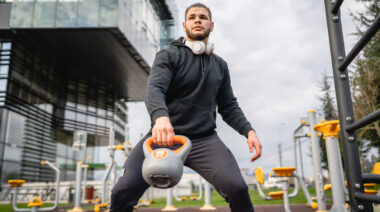After writing my Every Plan Has Holes: Connecting the Shoulders, Hips, and Core article, I played around with different versions of the workout in our training sessions. I came up with one that seemed particularly evil. It was one of those workouts that had people telling me a few days later they were still feeling the aftereffects.
The Original Workout
The intention of the original workout was to work shoulder stability, grip, trunk strength, and hips – and also to get people breathing heavily while doing so. The workout was:
- Farmer’s walks x 30m
- Sumo double kettlebell deadlifts x 20
- Rack walks x 30m
- Crawl x 30m
- Double overhead walk x 30m
- Ski erg x 1min
All movements should be done as heavy as possible. For the farmer’s walk, we start at bodyweight as our guide. For rack walks, use the heaviest pair of kettlebells you can clean. And for overhead walks, use one bell size above what you can press for a few reps.
The first round should be treated as a warm up. We simply had people pick weights a little lighter than they were planning to use for the rest of the workout. In the hour, people were getting five rounds.
Like with every workout, there are holes in this, and the biggest problem for me was that it taxes the whole body leaving people unable to train well for a few days afterwards. So I played around with the format a bit and came up with two different carry-based workouts that are both equally challenging, but for different reasons.
Carry Workout: Option 1
- Double kettlebell press x 10
- Overhead walk x 2mins
3 rounds done with a partner as I-go-you-go.
- Double kettlebell clean x 10
- Rack walks x 2mins
3 rounds done with a partner as I-go-you-go.
- Heavy kettlebell two-hand swings x 10
- Farmer’s walks x 2mins
3 rounds done with a partner as I-go-you-go.
The idea with this was to use the carry as a cardio option, like you would with interval weight training (IWT). For those unfamiliar with IWT, the basic premise is that you use a big lift, preferably a full-body lift, and follow it with two minutes of hard cardiovascular work. I wanted to see what would happen using weights for cardio instead of actual cardio, as there have been some good discussions going on recently.

The first thing I’ll say about this workout is don’t be greedy with the weights you pick. The guy I was training with and I were using 16kg bells for the overhead walks (and I even dropped down to 14kg on the final set). By the time we had gone through the press and overhead walk series, my arms and shoulders were already on fire.
The rack walks are horrible if you’ve never done them before. Breathing becomes almost impossible and your entire upper body seems to be needed to hold everything in place. Don’t be lazy and allow yourself to slump into a sloppy rack position. The gold is in fighting against the load and trying to maintain a strong posture.
Finally, the farmer’s walk series. Two minutes is a long time to hold onto something and walk without changing grip. We used 20kg bells, but could have gone heavier.
The entire thing was an hour from start to finish and my upper body was fatigued for two days after. (Side note: don’t do this workout the day before you need to swim 3km.) It makes an excellent choice for strength work at the end of a week, and doesn’t need weights as heavy as the original version, which makes it safer. In terms of the cardio, you’ll certainly get increased strength endurance from the muscles involved, but don’t plan on any fitness benefits other than that.
Carry Workout: Option 2
The idea with this was to go for the exact opposite feel of Option 1 – do a carry and follow it with an actual cardiovascular exercise for two minutes, as per an IWT. I also wanted to pick a cardio option that matched well with the carry used. Here’s how it went:
- Overhead walk x 30m
- Ski erg x 2mins
3 rounds done with a partner as I-go-you-go.
- Rack walks x 30m
- Airdyne x 2mins
3 rounds done with a partner as I-go-you-go.
- Farmer’s walks x 30m
- Row x 2mins
3 rounds done with a partner as I-go-you-go.
The much shorter carries necessitated going far heavier than the first workout option. For the first round, that doesn’t create it a problem, but once you factor in the elevated heart rate from the cardio, it does make the second and third rounds far more challenging. If people have selected the right loads, this won’t be a problem.

One thing I do find – and this is a caution no matter which format you choose to do the carries in – is that double overhead walks can be problematic for people. Most people do not have a good overhead position and getting them to stabilize there for long periods of time can lead to issues. I’ve had people complain of sore necks, shoulders, and backs simply from having arms overhead for long periods of time (and then usually get asked why I don’t teach them full Olympic lifts, too).
The bottom line is that overhead carries will quickly expose people’s weaknesses in that position. If you’re doing the long version with the two-minute carries, people will compensate for their weaknesses with something else, so be very careful with these.
My preferred version of this workout is Option 1 as it taxes the upper body fully while targeting many qualities of stability. The only proviso I would add is that people need a solid ability to get overhead with a vertical torso and no compensations before you let them do this, otherwise there will be some problems.
Photos courtesy of Shutterstock.






